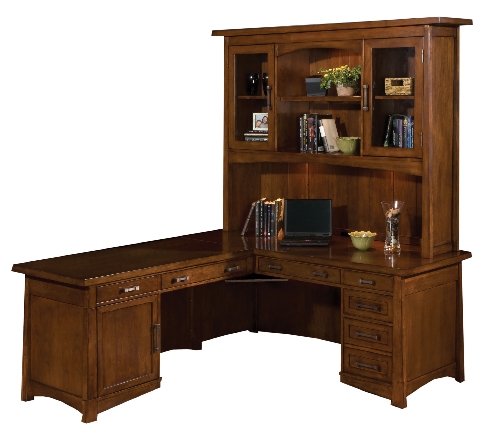Home work
When computers first arrived on the home front, the size of the hard drives and equipment necessary to work from home pretty much required that a room be transformed into an office.
But today, with the multitude of laptop and handheld devices, even though people still do plenty of work at home, they no longer need to have an office per se. With the right piece of furniture, a home office can be tucked into a corner in a bedroom or sitting in the middle of the family room.
"I think that you'll still find people that do have dedicated home offices. If it's not a dedicated room, it could be a corner in their bedroom, a spot in their kitchen or in the den," said Gail Schwartz, director of merchandising for Bush. "People are finding creative ways to work from home, and with wireless technology, the office travels with you."
"Home work space is the most changing landscape in our industry. No longer is a dedicated room the most popular area for working at home. Individual and personal decisions directed by the type of work, method of work and amount of space available are determining the area dedicated for work," agreed Bryan Edwards, apsenhome's vice president of sales. "Many people are combining their working space into their daily home life."
As a result, aspenhome created a new concept to help people identify their working habits and how they can incorporate office space into their home décor. Works For Me offers ideas to customize a space with furniture that suits each person's lifestyle and how and where he or she works.
The work space concepts provide desks and supporting pieces that let people set up office space virtually anywhere in the home.
For example, Focal Point might target the younger generation whose work space is in the middle of their living area, said Renee Loper, director of marketing and communications. The desk may include a hutch with display space or be near enough to the television so a computer or laptop can be connected.
Social Living also puts the desk in the main part of the home, but on the perimeter of the living space. A small writing desk could double as a sofa table in this scenario, Loper said.
Night Work creates a personal work space in the bedroom, where it can double as a nightstand.
Because these miniature offices must fit into rooms where there will be other furnishings, features such as built-in outlets and USB hubs, hidden storage drawers and cord management are being incorporated into the pieces.
"We're working on that," Schwartz said. "We call it the anywhere office. It could be a benign piece of furniture that looks like a console or a little dresser, but when it opens up you can store your laptop, it has integrated technology and a file drawer inside a cabinet drawer. It doesn't look like an office but it provides decent work space and a storage area."
Features such as store-charge drawers, hidden file cabinets and flip-down drawer fronts to accommodate a laptop are also included in aspenhome's desk-chests, writing desks and desk-credenzas.
"As technology continues to be an integral part of our plug-in lives, we not only need a spot to set up our computers, scanners and printers, but also a spot to charge and store our cell phones, iPods and other necessary gadgets," Edwards said.
Even though the pieces function as desks, they don't look utilitarian -- unless, of course, that is the look you are going after. Today's home office furniture designers have created stylish pieces that suit any décor. Whether your style is modern, traditional or transitional, you can find a "desk" that blends with the other furnishings in your home.
"Everybody seems to want something that works in their home and with their décor. We try to develop product that has that flexibility, that styling, that fits into many different types of décor," Schwartz said.
Included among Sligh Furniture's most popular collections are a desk-credenza with a hutch and a small scale table-desk. These pieces offer great flexibility in how they can be used in a room.
Its collections also include bunching bookcases, said Rob Sligh, president. These are versatile pieces that can be bunched together as space permits to create a larger unit or double as media centers.
Sligh's entry-level brand, Loft 102, debuted the Landsdown collection during the recent summer show at World Market Center. It offers several mix and match pieces to create a working space that doesn't look like a traditional desk. The tablelike desk has a flip-down center keyboard drawer, laptop port with three outlets and storage drawers with a pencil tray. Sligh said the piece is non-handed, which means the two fixed shelves can be attached on the right or left side, depending on preferences. The back of the shelf is removable so it has a more decorative look.
Additionally, the collection includes a deck with drawers and storage space, return, portable file cabinet and matching bookcases and media console.
Of course, there still are plenty of options available for those who prefer to have a true home office. But like their chameleonlike counterparts, the desks, credenzas and returns have built-in features such as outlets and USB hubs, durable writing surfaces and hidden storage and file drawers.



















